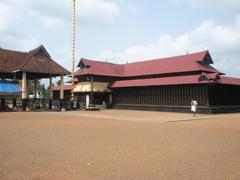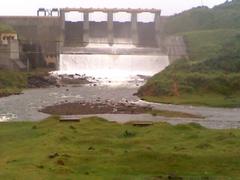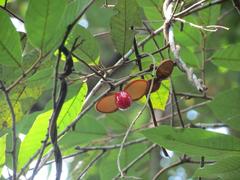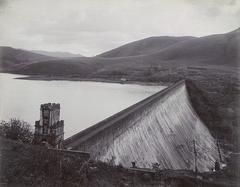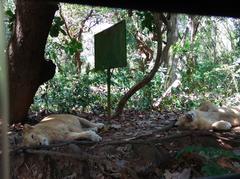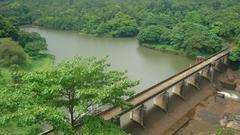Maniyar Dam Visiting Hours, Tickets, and Travel Guide in Kerala
Date: 04/07/2025
Introduction
Maniyar Dam, set amidst the lush hills of Pathanamthitta district in Kerala, is a testament to the convergence of engineering innovation, environmental stewardship, and cultural heritage. Commissioned as part of the Pampa Irrigation Project and built across the Kakkadu River (a Pamba River tributary), the dam is instrumental in supporting regional irrigation, hydroelectric power generation, and flood control. Its construction in the early 1990s, through public-private partnership models like Build-Operate-Transfer, highlights Kerala’s commitment to sustainable infrastructure and the preservation of the Western Ghats’ ecological treasures (Wikipedia; Kerala Marine Life Journal; Construction World).
Surrounded by verdant forests and habitats for endangered species, Maniyar Dam is now a favorite for eco-tourists, birdwatchers, and photographers. Attractions include the historical British-era suspension bridge and colonial bungalows, offering a blend of natural and cultural experiences (onmanorama.com).
The dam is open daily from morning until evening, with free general access. Activities range from peaceful walks and picnics to educational hydroelectric facility tours (with prior permission) (TripInIC; yappe.in). Its location, about 20–30 kilometers from towns like Pathanamthitta and Ranni, makes it accessible yet tranquil.
This comprehensive guide provides detailed insights into Maniyar Dam’s history, significance, environmental context, visiting hours, ticketing, facilities, nearby attractions, and essential tips for a safe and memorable visit.
Historical Background and Significance
Strategic Location and Development
Maniyar Dam is strategically located to harness the Pamba River system’s potential for irrigation and hydroelectricity. The dam supports agriculture, industry, and local communities through its water and energy management (Wikipedia).
Maniyar Hydro Project Genesis
Commissioned in 1994 by Carborundum Universal Limited (CUMI) under the BOT model, the Maniyar Hydroelectric Plant set a precedent for public-private partnerships in Kerala’s energy sector (CUMI History; Construction World). With a 12 MW generation capacity, the plant continues to bolster the region’s power supply.
Technical and Operational Milestones
Over the decades, Maniyar Dam has seen technical upgrades and contract renewals, reflecting its lasting importance in Kerala’s energy and irrigation landscape.
Maniyar Dam: Practical Visitor Information
Visiting Hours
- General Opening: 8:00 AM – 6:00 PM daily.
- Best Visiting Window: October to March, when the climate is most pleasant.
- Special Closures: Check locally for seasonal or maintenance closures.
Tickets and Entry Fees
- Entry Fee: Free for general visits.
- Special Tours: Guided hydroelectric plant tours require prior permission and may have specific guidelines.
Accessibility
- By Road: 20–30 km from Pathanamthitta and Ranni; accessible by bus, taxi, or private vehicle (TripInIC; yappe.in).
- Nearest Railway Station: Murahara, about 8.7 km away.
- Parking: Ample parking for vehicles.
Facilities and Amenities
- Food & Refreshments: Limited options; carry your own snacks and water.
- Rest Areas: Some benches and shaded spots, but facilities are basic (onmanorama.com).
- Restrooms: Basic, may not meet high tourist standards.
- Accessibility for Differently-abled: Limited; plan ahead if needed.
Attractions and Activities
- Dam and Reservoir: Picturesque views, especially post-monsoon.
- Historic Suspension Bridge: British-era bridge for unique walks and views (onmanorama.com).
- Colonial Bungalow: Heritage structure accessible to enthusiasts (check local access).
- Nature Walks & Birdwatching: Rich in birdlife and natural beauty.
- Hydroelectric Plant Tour: Educational tours available by advance arrangement (yappe.in).
- Nearby Attractions: Sabarimala, Perunthenaruvi Waterfalls, Pandalam Palace, Konni Elephant Reserve.
Environmental and Socio-Economic Impact
Irrigation and Agriculture
Maniyar Dam is essential for irrigating paddy, coconut, and cash crops in Pathanamthitta, stabilizing yields and supporting livelihoods (Kerala Marine Life Journal).
Hydroelectric Power
The dam’s 12 MW power plant contributes to Kerala’s green energy goals, reducing reliance on fossil fuels.
Flood Control
Sluice gates and outlets manage monsoon floods, protecting downstream communities (Manorama Online).
Fisheries and Ecology
The reservoir supports diverse fish species and aquaculture, providing supplementary income to locals. Regular water quality monitoring ensures ecological balance (Kerala Marine Life Journal).
Tourism and Community
The dam has spurred local tourism and infrastructure, supporting small businesses and promoting sustainable, community-engaged resource management.
Visitor Guidelines and Safety
- Monsoon Safety: Trails and bridges can be slippery; wear sturdy shoes.
- Swimming: Not advised due to strong currents.
- Waste Disposal: Carry back all litter as facilities are limited.
- Wildlife: Stay alert, especially when exploring forested areas.
- Permissions: Arrange plant tour permissions in advance.
Emergency Contacts
- Police: 100
- Fire: 101
- Ambulance: 102/108
- Highway Alert: 9846 100 100
- Railway Alert: 9846 200 100
Best Time to Visit
- October–March: Cool and comfortable, ideal for outdoor activities.
- June–September: Lush landscapes during monsoon, but some trails may be inaccessible (travellersworldwide.com; easeindiatrip.com).
- April–May: Hot and humid, less comfortable for exploration.
Local Culture and Etiquette
- Languages: Malayalam (official), English widely spoken.
- Dress: Modest attire recommended; respect local customs.
- Support Locals: Purchase from local shops and artisans.
Sustainable Tourism Tips
- Use reusable containers.
- Dispose of waste responsibly.
- Respect wildlife and local culture.
- Participate in community-led activities where possible.
Frequently Asked Questions (FAQs)
Q: What are Maniyar Dam’s visiting hours?
A: 8:00 AM – 6:00 PM daily.
Q: Is there an entry fee?
A: No, entry is free.
Q: Are guided tours available?
A: Yes, with prior permission for hydroelectric plant tours.
Q: Is it safe for children and families?
A: Yes, but supervise children near water and bridges.
Q: Is Maniyar Dam accessible for differently-abled visitors?
A: Main viewing areas are vehicle-accessible; some paths and bridges may not be suitable.
Q: Can I swim or fish in the reservoir?
A: Swimming is not advised; fishing is regulated.
Q: Are there food outlets nearby?
A: Limited; advisable to bring your own snacks and water.
How to Plan Your Visit
- Duration: 2–4 hours for full experience.
- Bring: Water, snacks, rain gear (monsoon), camera, binoculars, first-aid kit.
- Transport: Private vehicle or taxi is most convenient; public buses connect to Pathanamthitta and Ranni.
Conclusion
Maniyar Dam stands as a harmonious blend of natural splendor, cultural heritage, and engineering achievement. Its vital role in regional irrigation, renewable energy, and tourism makes it a must-visit destination in Kerala. Whether you’re seeking a peaceful retreat, a learning experience, or a day of exploration, Maniyar Dam offers it all. Plan your visit during the best months, follow safety guidelines, and immerse yourself in the tranquil ambiance of Pathanamthitta’s iconic landmark.
For the latest updates, guided tours, and travel tips, download the Audiala app and explore our related articles on Kerala’s historic sites and hidden gems.
Sources and Further Reading
- Maniyar, Pathanamthitta - Wikipedia
- History of CUMI - Carborundum Universal Limited
- Kerala CM backs expansion of Maniyar Hydro Project - Construction World
- Kerala Marine Life Journal, Vol 2-2
- Manorama Online - Maniyar Barrage Flood Control
- IndusEdu Journal on Dam Impacts
- Kerala Backwaters History, Culture & Economy - CareerIndia
- Best Time to Visit Kerala - Travellers Worldwide
- Maniyar Dam Tourism Project - OnManorama
- Maniyar Dam Visitor Information - TripInIC
- Maniyar Dam Visitor Guide - Yappe.in
- Dams in India and Sedimentation Challenges - Vajiram & Ravi
